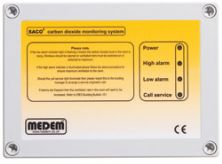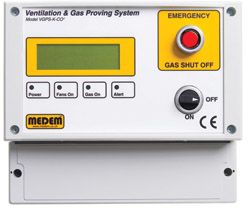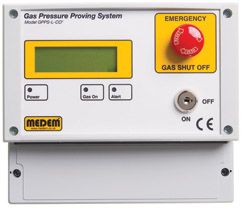Monitoring carbon dioxide levels to adjust and control heating and air conditioning ventilation rate depending on the occupancy level of a building is a tried-and-tested method of minimising a building's energy use. Chris Dearden, managing director of Medem UK, explains.

2 in schools'>
Carbon dioxide (CO
2) is a colourless, odourless gas - outdoor air will typically have 350-400 parts per million (ppm) or 0.04 per cent. It is produced when any carbon-based material (coal, oil, wood, etc) is burned, and through human, animal and plant respiration.
CO
2 is not generally found at hazardous levels indoors, but it is often measured when trying to determine the indoor air quality of a building as it can provide an indication of the number of occupants. If the levels of CO
2 are high, it is assumed there may not be adequate ventilation to that area which, in turn, may allow for the build up of other environmental contaminants.
For a medium quality of indoor air, CIBSE recommends a concentration of CO
2 of no more than 900 ppm. The guideline values are based on the association of elevated carbon dioxide concentrations with unacceptable levels of body odour, and not on any health or comfort impacts of carbon dioxide itself.
Far higher levels are found in some industrial settings and exposure to levels between 10,000 and 15,000 ppm can cause changes in breathing patterns. Occupants may experience health effects at much lower concentrations but this is likely to be attributed to other contaminants in the air that are allowed to build up as a result of insufficient ventilation.
Carbon dioxide produced as a metabolic emission by people and from other sources such as vehicle emissions can contribute to the overall indoor levels. When an average adult (or older student) exhales, the proportion of carbon dioxide is 35,000-50,000 ppm - this equates to about 0.01 grams per second (g/s) (about 0.005 l/s).
Younger people have lower emission rates but, as they are likely to be more active in the classroom, their carbon dioxide production may well be at similar levels.
When CO
2 is being produced within a space, some basic modelling may be used to determine the effect of various ventilation rates. The CO
2 concentration may be calculated from:

The Medem VGPS-K-CO2 is designed for commercial kitchens
Ct = ((CO
2 + 106 x P/Q) x (1-e-nt)) + Ci x e-nt where C is the concentration of CO
2 (ppm) with suffixes t = after time t, i = initial (at time = 0), O = outdoor air.
P is the rate of release of CO
2 (for example in m3/s), Q is the outdoor air supply rate (in the same units as P, eg, m3/s), t is the time (eg, number of hours) and n is the room air change rate per unit time (eg, room volume in m3/Q x 3600) and e = 2.72 (the base of natural logarithms).
So, for example, if a 10 x 6 x 3m high (ie, 180m3) classroom had been unused all weekend and at 9am Monday morning 30, 18-year-olds each exhaling 0.00 5l/s of CO
2 (ie, total 0.15l/s) entered the room where the fresh air (at 400 ppm) ventilation rate was two air changes per hour (ie, 100 l/s), the predicted CO
2 level at midday (ie t = 3 hours) would be:
CO
2 at midday = [((400 + (106 x 0.15/100)) x (1-e-(2 x 3))] + (400 x e-(2 x 3)) = [((400 + (106 x 0.0015)) x (1-0.0025)] + (400 x 0.0025) @ 1900 ppm.
Building Bulletin 101 quotes a study in a school where, typically, CO
2 levels in classrooms rose from the start of each day, reached a peak before lunch at about 12.30pm, and then decreased during the lunch period when the classroom was empty. After lunch, when the classroom was occupied, CO
2 levels increased, reaching a peak at the end of the school day at 3.30pm.

The Medem GPPS-L-CO2 is designed for laboratories
CIBSE recommends that, assuming an outdoor CO
2 level of 400 ppm, the fresh air supply rate should not fall below 8l/s per adult occupant to maintain an indoor level of 1000 ppm. Building Bulletin 101 suggests a minimum ventilation rate of 3 l/s per person, a minimum daily average of 5 l/s per person with the capability of 8 l/s minimum per person at any occupied time.
In many cases, it may be expedient to provide increased levels of outdoor air to provide 'free' cooling into the space. The amount of outdoor air supplied to a room for the purposes of CO
2 dilution may well be far less than is required for good air movement and for heating or cooling purposes - in this case, where mechanical ventilation is used, opportunities for recirculation air systems should be explored.
CO
2 levels can be monitored using special instruments. For example, Medem currently offers three systems that do precisely this.
Designed for the classroom
The SACO
2 is either a standalone monitor or can operate mechanical ventilation in relation to the carbon dioxide levels. This system is designed for classroom use in educational buildings. (Medem also offers the VGPS-K-CO
2 designed for commercial kitchens and the GPPS-L-CO
2 designed for laboratories.)
The SACO
2 panel has been designed to monitor the CO
2 level in classrooms in accordance with Building Bulletin 101. This provides the regulatory framework in support of the Building Regulations for the adequate provision of ventilation in schools.
It deals with the design of school buildings to meet the ventilation requirements of both The School Premises Regulations and the Building Regulations Part F (Ventilation).
The SACO
2 panel can be used as a monitor to advise when the CO
2 level is high. It can also control mechanical ventilation in order that the rate of air change can be controlled depending on the occupancy level of the room to cut heat loss in winter.